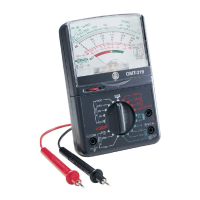12
Common AC Voltage Measurements
6.1 Wall Receptacles
If the receptacle is controlled by a switch, make sure the
switch is ON. Set the function/range switch to 250 ACV.
Touch the test leads to the “hot” and “neutral” slots of the
receptacle (see fig. 5.) The needle indicator should read 120
VAC on the 0-250 scale. To test for proper grounding of the
receptacle, touch one test lead to the “hot” (narrow) side of
the receptacle, and the other test lead to the ground slot.
The tester should read 120 VAC as before. To test for proper
grounding of non- polarized receptacles (fig.6), alternately
touch the test leads between the receptacle slots and the
wall plate screw. The tester should indicate 120 VAC when
one test lead contacts the “hot” side of the receptacle. If
ground contact cannot be made on the wall plate screw,
remove the wall plate and touch the electrical box with the
test lead in the same manner as before. The tester should
read 120 VAC with one test lead touching the electrical box
and the other touching the live side of the receptacle. If not,
the receptacle is not properly grounded.
11
1 ) Fully seat the test leads in the correct input jacks.
2) Set the function/range switch to the appropriate AC
voltage range. If the voltage is unknown, use the highest
range. If the voltage applied falls within the range of a
lower setting, reset the function/range switch to the
appropriate setting for greatest accuracy of reading.
3) Touch the test leads to the circuit under test. With AC
voltage, the polarity of the test leads is not a factor.
Use the following chart below as a guide to reading AC
voltage measurements:
ACV Read and
Range Following Multiply
Setting
Scale Reading By:
10 0-10 1
50 0-50 1
250 0-250 1
1000 0-10 100
6.0 AC Voltage Measurement

